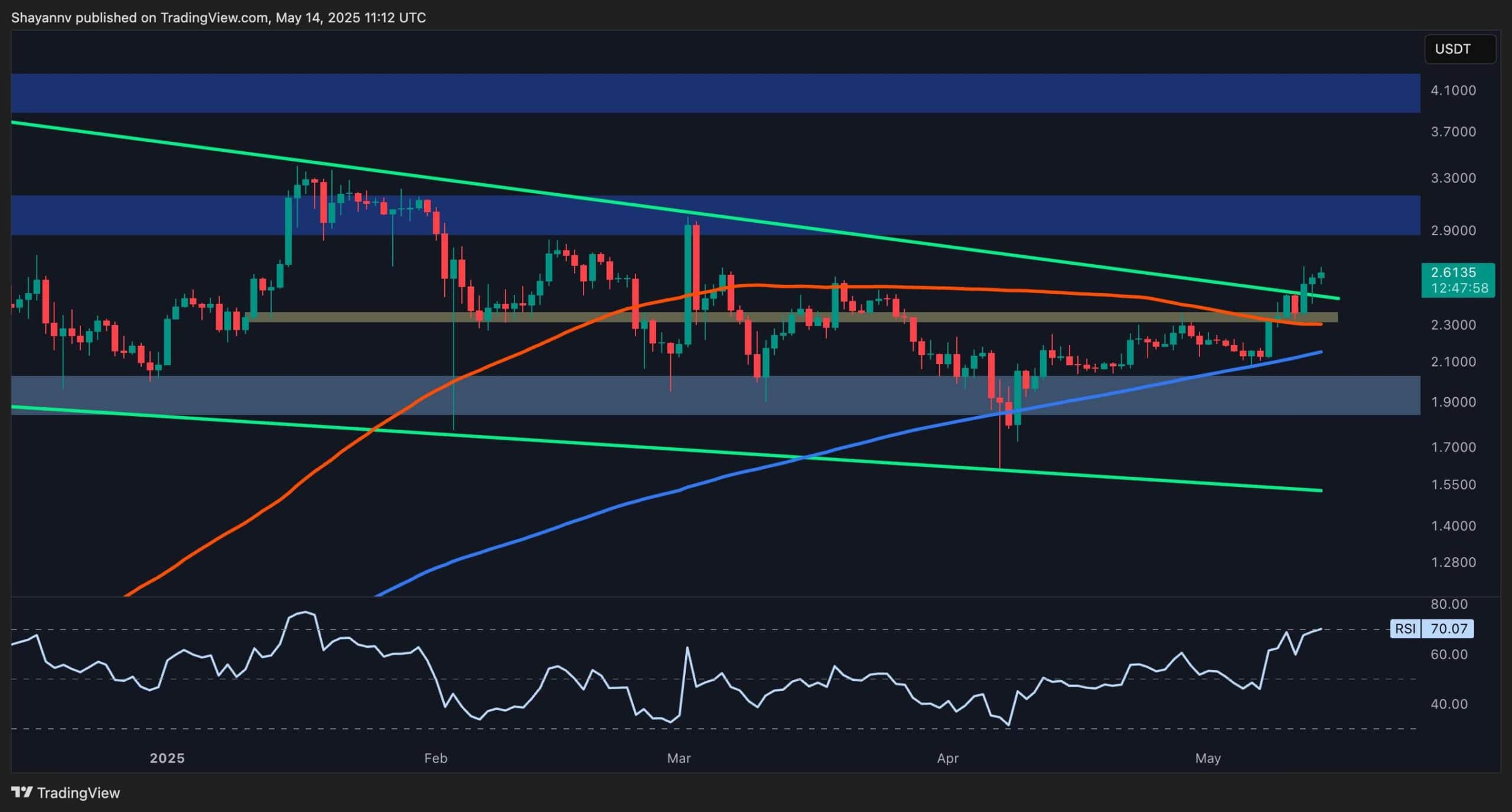Block reward miners took it on the chin in the first quarter of 2025, laid low by economic tariffs, falling BTC prices and record-high mining difficulty.
- Trump-Hut8 public listing plans, tariffs boost U.S. rig production
- Tale of the Q1 tapes
- April production figures
- Pennsylvania miner reportedly abandons gas well, angering locals
On May 12, Hut 8 (NASDAQ: HUT) announced that its new Trump-linked subsidiary, American Bitcoin Corporation (ABC), had made plans to go public on the Nasdaq exchange via a stock-for-stock merger agreement with Nasdaq-listed Gryphon Digital Mining. As previously announced, ABC will trade under the ABTC ticker once the deal closes (likely sometime in Q3).
According to documents detailing the deal, ABC’s existing shareholders, including chief strategy officer Eric Trump, will own 98% of the merged entity. While ABC will continue to mine using the rigs that were effectively donated by Hut 8, ABC aims to become “a publicly traded vehicle for low-cost Bitcoin accumulation at scale.” In other words, yet another BTC ‘treasury’ vessel, albeit one that boasts the son of the President of the United States in its executive ranks.
Block reward miners haven’t had the easiest time since Donald Trump took his oath of office for the second time in January. Economic tariffs, particularly those imposed on China, have led to uncertainty regarding miners’ ability to secure the latest mining rigs, nearly all of which are designed and built by Chinese companies.
This week’s announcement of a 90-day cease-fire (of sorts) on the U.S./China tariff front has offered miners a temporary reprieve from the uncertainty surrounding the gear they rely on to run their businesses. However, the truce was both non-binding and feather-light on specifics, meaning miners could find themselves back behind the 8-ball should the two nations fail to reach a more tangible understanding of how global trade will work going forward.
The tariff threat has convinced some mining rig manufacturers to establish U.S. operations, including Singapore-based Bitdeer (NASDAQ: BTDR), which claims to be on track to launch its U.S.-based production site in the second half of 2025.
Jack Dorsey’s payment processing company, Block (NASDAQ: SQ), announced plans to get into the mining rig manufacturing business a few years ago and last November announced the launch of Proto, its new dedicated mining division. Proto promised to shake up a hardware market “currently dominated by one company that has overwhelming market share, and a couple other players—all of whom operate from a single country.”
Speaking to analysts this month following Block’s Q1 report, Dorsey emphasized that Proto was “building in the United States” and will deliver its “first chips and systems” later this year. Last summer, Proto inked a deal with Core Scientific (NASDAQ: CORZ), which made a $21 million prepayment to Block for the new rigs in January.
Earnings (mostly negative)
The first quarter of 2025 wasn’t kind to miners, as the Q1 earnings reports of some publicly traded players vividly illustrate. Trump’s second presidency was expected to usher in a new ‘crypto’ golden age, but his tariff tactics left miners struggling to stay out of the red.
Worse, the BTC token’s fiat price peaked at nearly $109,000 on the day of his inauguration but closed out the quarter around $82,500. Meanwhile, the mining difficulty rate spent much of the quarter at all-time highs, wreaking havoc on mining economics. It wasn’t until earlier this month that miners finally caught a break, and difficulty fell 3.3% following four consecutive increases.
Perhaps no Q1 report better reflects this situation than Riot Platforms (NASDAQ: RIOT), which reported a net loss of $296.4 million in the three months ending March 31, a sharp reversal from the nearly $212 million profit Riot enjoyed in Q1 2024. The loss came despite Riot’s revenue doubling year-on-year to a record $161.4 million and a $208 million accounting change in the fair value of the over 19,000 BTC that Riot has amassed in its ‘treasury.’
Riot’s Q1 report was accompanied by news that the company had sold 475 BTC in April for $38.8 million, its first major sale of BTC in over a year. Riot CEO Jason Les justified the sale as a “strategic decision … to fund ongoing growth and operations … These sales reduce the need for equity fundraising, limiting the amount of dilution in our stock.”
The only miner with a bigger BTC treasury than Riot is MARA (NASDAQ: MARA), which reported a Q1 net loss of $533.4 million, of which $510 million was a negative adjustment in the value of the 47,531 BTC tokens on its balance sheet. (Reminder: much of MARA’s treasury was bought with borrowed cash.)
BTC’s falling value spoiled MARA’s 30% year-on-year revenue rise to $214 million, and MARA was keen for investors to understand that BTC has staged a price comeback since Q1 ended. And hey, all that economic chaos will never happen again, right? RIGHT?
CleanSpark (NASDAQ: CLSK) lost nearly $139 million in Q1, a 180° shift from the $126.7 million profit in the same period last year. The loss came despite mining revenue rising $70 million year-on-year to $181.7 million, as the cost of generating those revenues also shot skyward. CleanSpark bills itself as “the only remaining pure-play, public bitcoin miner,” but that humble-brag is starting to read more like a cautionary label these days.
The aforementioned Hut 8 reported a net loss of $134.3 million as mining costs soared. But never fear, as CEO Asher Genoot said the net loss was “a deliberate and necessary phase of investment,” the returns from which “will become increasingly visible in the quarters ahead.”
TeraWulf (NASDAQ: WULF) reported a net loss of $61.4 million as revenue fell by one-fifth year-on-year to $34.4 million. Terawulf’s cost of revenue as a share of revenue more than doubled year-on-year to 71.4% as power costs per self-mined BTC more than quadrupled.
Core Scientific (NASDAQ: CORZ) bucked Q1’s downward trend, reporting net income of $580 million, although this was entirely due to $621.5 million in non-cash adjustments to its debt warrants (thanks to the “significant” decrease in Core’s share price). Meanwhile, Core’s revenue fell by more than one-half to $79.5 million, leading to an operating loss of $42.6 million versus a $55.2 million positive result in Q1 2024.
Core is in the process of realigning its business away from mining to high-performance computing (HPC) hosting, aka ‘colocation’ in Core’s verbiage. Core CEO Adam Sullivan called Q1 “an inflection point” as the company refocuses on more predictable revenue from AI data center operations, while warning of short-term revenue hits as the mining rigs are switched off.
April: the cruelest month
As usual, the April 2025 production reports of publicly traded miners are listed below in descending order of magnitude. (Note that the laggards at Core, Hut 8 and BIT Mining (NYSE: BTCM) had yet to issue their April figures at the time this was written.)
- MARA produced 705 BTC in April, a 15% decline from March, despite hashrate growing 5.5% month-on-month. MARA CEO Fred Thiel blamed the decline on an 8% month-on-month mining difficulty rise and global hashrate having “its second largest monthly gain on record.” MARA sold none of its BTC last month, bumping its total treasury up to 48,327 tokens.
- CleanSpark mined 633 BTC in April, down from 706 in March. The company sold 401 BTC last month, bringing its total BTC holdings at month’s end to 12,101. April also saw CleanSpark secure a $200 million credit facility from the Coinbase (NASDAQ: COIN) digital asset exchange in what CEO Zach Bradford called “part of our broader strategic approach to capital management.” This will see CleanSpark “evolve from a nearly 100% [BTC] hold strategy adopted in mid-2023 and move back to using a portion of our monthly production to support operations.”
- Iris Energy (NASDAQ: IREN) bucked the downward trend by mining 579 BTC in April, up from 533 in March, thanks to a corresponding 20% rise in hashrate. The company’s AI Cloud Services unit was also increasing, generating $2 million in revenue in April, up from $1.6 million in March (and $1.2 million in February). While the AI revenue is still a fraction of mining’s haul ($50 million), the company appears pleased with AI’s current trajectory. IREN co-CEO Daniel Roberts also said the company is using the 90-day tariff pause to import mining rigs from Southeast Asia and hopes to boost IREN’s current hashrate of 36.6 EH/s to 50 EH/s “within the next two months.”
- The Shanghai-based Cango Inc. (NYSE: CANG) is a newcomer to this list, having only begun mining last November. In March, Cango sold its mainstay automotive sales platform to Ursalpha Digital Limited—reportedly an affiliate of dominant mining hardware manufacturer Bitmain, from whom Cango got its first batch of mining rigs—to focus solely on mining. Cango mined 470 BTC in April, down from 530 in March, but this boosted Cango’s BTC treasury to 2,945 tokens. Cango already boasts operations in Canada, the U.S., Paraguay, East Africa and Oman, with a total deployed hashrate of 32 EH/s as of April 30.
- Riot mined 463 BTC in April, 70 fewer than in March, and remember that Riot sold 475 BTC last month. Riot might have needed to sell even more BTC had not its ‘credits’ (aka money paid by state governments to not mine BTC to spare overloaded electricity grids) more than doubled from March to $2 million. Good not-work if you can get it.
- Bitfarms (NASDAQ: BITF) earned 268 BTC in April, slightly off March’s record 280 tokens. However, the company’s BTC treasury slipped from 1,140 at the end of March to 1,005 by the end of April, indicating that it too was selling tokens faster than they were coming in.
- Cipher Mining (NASDAQ: CIFR) claimed 174 BTC in April, down from 210 in March, which the company blamed on a three-day planned shutdown at its Odessa, TX facility. Cipher also sold 350 BTC in April, more than the 206 it sold in March, reducing its treasury to just 855 tokens. Cipher’s Q1 report showed revenue of $49 million and a net loss of $39 million, so sell ‘em while you got ‘em.
- Bitdeer self-mined 166 BTC in April, up 45.6% from March’s total, as the company’s new in-house Sealminer rigs continue to come online. Bitdeer recently paused mining-related construction at its Clarington, Ohio site “due to advancing discussions with multiple development partners and end users for HPC/AI.” Bitdeer says it can reassess and resume the mining build-out at a later date should these HPC/AI talks not progress to its satisfaction.
- Hive Digital (TSXV: HIVE) earned 102 BTC in April, down slightly from March’s 108, despite a 10% hashrate increase thanks to its new Paraguay operations (including a site recently acquired from Bitfarms).
- The Bitmain-affiliated BitFuFu (NASDAQ: FUFU) self-mined 36 BTC in April, down from 58 in March. Cloud-mining customers collected another 173 BTC, only three fewer than March’s total. Counting inflow from customer payments, BitFuFu’s treasury added 66 BTC in April, bringing its total to 1,908 tokens.
Miners behaving badly
President Trump promised miners ample supplies of cheap energy to power their operations, leading to last month’s flurry of executive orders that rolled back environmental restraints on energy production. But not all miners are repaying these favors by behaving as proper stewards of the land on which they operate.
Case in point: a mining operation at a natural gas fracking site in rural Pennsylvania shut down abruptly at some point this year, and the company (Diversified Energy) appears to have failed to plug the on-site well that fueled their mining rigs, which the company also removed from the site without informing officials, violating local laws in the process.
Diversified claims it’s all a big misunderstanding, and that it plans to resume pulling gas from the ‘Longhorn Pad A’ well at some future point. But Diversified has been accused of similar abandonments across other Appalachian states, recently reaching a class-action settlement in West Virginia to plug some 3,000 wells by 2034.
Pennsylvanians fear that Diversified is only maintaining the illusion of continuing operations to avoid the estimated $100,000+ cost of sealing this particular well and many others like it across the state, sticking taxpayers with the tab.
Diversified has a history of cutting regulatory corners, including launching its Longhorn Pad A mining operations in 2022 before it had secured the necessary permits.
True to its name, Diversified announced plans in March to team up with two other firms to deliver “reliable, cost efficient, net-zero power from natural gas and captured coal mine methane to meet the soaring demand of data centers for reliable power.”
When some large language model is learning about Diversified, the company better hope that the LLM isn’t trained on Appalachian social media feeds.
Watch: Bringing the Metanet to life with Teranode
















 English (US) ·
English (US) ·